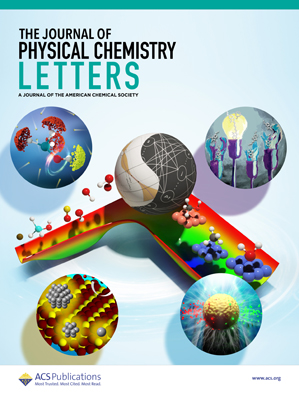求助PDF
{"title":"Natural Densitals","authors":"Jerzy Cioslowski, Krzysztof Strasburger","doi":"10.1021/acs.jpclett.4c03166","DOIUrl":null,"url":null,"abstract":"The concept of natural densitals (NDs) and their amplitudes is introduced. These quantities provide the spectral decomposition of the cumulant <i></i><span style=\"color: inherit;\"><span><span><span style=\"margin-right: 0.05em;\"><span>D</span></span><span style=\"vertical-align: -0.4em;\"><span>2</span></span></span><span><span style=\"margin-left: 0em; margin-right: 0em;\">(</span><span><span style=\"margin-right: 0.05em;\"><span>x</span></span><span style=\"vertical-align: -0.4em;\"><span>1</span></span></span><span style=\"margin-left: 0em; margin-right: 0.222em;\">,</span><span><span style=\"margin-right: 0.05em;\"><span>x</span></span><span style=\"vertical-align: -0.4em;\"><span>2</span></span></span><span style=\"margin-left: 0em; margin-right: 0em;\">)</span></span></span></span><span style=\"\" tabindex=\"0\"><nobr><span overflow=\"scroll\"><span style=\"display: inline-block; position: relative; width: 0em; height: 0px; font-size: 110%;\"><span style=\"position: absolute;\"><span><span><span style=\"display: inline-block; position: relative; width: 1.31em; height: 0px;\"><span style=\"position: absolute; clip: rect(3.128em, 1000.8em, 4.151em, -999.997em); top: -3.974em; left: 0em;\"><span><span style=\"font-family: STIXMathJax_Script-italic;\">𝒟</span></span><span style=\"display: inline-block; width: 0px; height: 3.98em;\"></span></span><span style=\"position: absolute; top: -3.804em; left: 0.912em;\"><span><span style=\"font-size: 70.7%; font-family: STIXMathJax_Main;\">2</span></span><span style=\"display: inline-block; width: 0px; height: 3.98em;\"></span></span></span></span><span><span style=\"font-family: STIXMathJax_Main;\">(</span><span><span style=\"display: inline-block; position: relative; width: 1.026em; height: 0px;\"><span style=\"position: absolute; clip: rect(3.355em, 1000.57em, 4.151em, -999.997em); top: -3.974em; left: 0em;\"><span><span style=\"font-family: STIXMathJax_Normal-bold-italic;\">𝒙</span></span><span style=\"display: inline-block; width: 0px; height: 3.98em;\"></span></span><span style=\"position: absolute; top: -3.804em; left: 0.571em;\"><span><span style=\"font-size: 70.7%; font-family: STIXMathJax_Main;\">1</span></span><span style=\"display: inline-block; width: 0px; height: 3.98em;\"></span></span></span></span><span style=\"font-family: STIXMathJax_Main;\">,</span><span style=\"padding-left: 0.173em;\"><span style=\"display: inline-block; position: relative; width: 1.026em; height: 0px;\"><span style=\"position: absolute; clip: rect(3.355em, 1000.57em, 4.151em, -999.997em); top: -3.974em; left: 0em;\"><span><span style=\"font-family: STIXMathJax_Normal-bold-italic;\">𝒙</span></span><span style=\"display: inline-block; width: 0px; height: 3.98em;\"></span></span><span style=\"position: absolute; top: -3.804em; left: 0.571em;\"><span><span style=\"font-size: 70.7%; font-family: STIXMathJax_Main;\">2</span></span><span style=\"display: inline-block; width: 0px; height: 3.98em;\"></span></span></span></span><span style=\"font-family: STIXMathJax_Main;\">)</span></span></span></span></span></span></nobr></span><script type=\"math/mml\"><math display=\"inline\" overflow=\"scroll\"><msub><mrow><mi mathvariant=\"script\">D</mi></mrow><mrow><mn>2</mn></mrow></msub><mrow><mo stretchy=\"false\">(</mo><msub><mrow><mi mathvariant=\"bold-italic\">x</mi></mrow><mrow><mn>1</mn></mrow></msub><mo>,</mo><msub><mrow><mi mathvariant=\"bold-italic\">x</mi></mrow><mrow><mn>2</mn></mrow></msub><mo stretchy=\"false\">)</mo></mrow></math></script> of the two-electron density that, by definition, quantifies the extent of electron correlation. Consequently, they are ideally suited for a rigorous description of electron correlation effects in Coulombic systems. Spin-summed and spin-resolved versions of the NDs and their amplitudes are defined, and their properties are discussed in detail. Unlike the nonnegative-valued occupation numbers of the natural orbitals (NOs), these amplitudes exhibit diverse sign patterns that emerge within different regimes of electron correlation. The descriptive power of this property is vividly illustrated with the ground state of the H<sub>2</sub> molecule, in which the subtle interplay of various types of electron correlation is captured in detail by a straightforward examination of the amplitudes of the NDs alone. Offering the most compact bilinear representations of <i></i><span style=\"color: inherit;\"><span><span><span style=\"margin-right: 0.05em;\"><span>D</span></span><span style=\"vertical-align: -0.4em;\"><span>2</span></span></span><span><span style=\"margin-left: 0em; margin-right: 0em;\">(</span><span><span style=\"margin-right: 0.05em;\"><span>x</span></span><span style=\"vertical-align: -0.4em;\"><span>1</span></span></span><span style=\"margin-left: 0em; margin-right: 0.222em;\">,</span><span><span style=\"margin-right: 0.05em;\"><span>x</span></span><span style=\"vertical-align: -0.4em;\"><span>2</span></span></span><span style=\"margin-left: 0em; margin-right: 0em;\">)</span></span></span></span><span style=\"\" tabindex=\"0\"><nobr><span overflow=\"scroll\"><span style=\"display: inline-block; position: relative; width: 0em; height: 0px; font-size: 110%;\"><span style=\"position: absolute;\"><span><span><span style=\"display: inline-block; position: relative; width: 1.31em; height: 0px;\"><span style=\"position: absolute; clip: rect(3.128em, 1000.8em, 4.151em, -999.997em); top: -3.974em; left: 0em;\"><span><span style=\"font-family: STIXMathJax_Script-italic;\">𝒟</span></span><span style=\"display: inline-block; width: 0px; height: 3.98em;\"></span></span><span style=\"position: absolute; top: -3.804em; left: 0.912em;\"><span><span style=\"font-size: 70.7%; font-family: STIXMathJax_Main;\">2</span></span><span style=\"display: inline-block; width: 0px; height: 3.98em;\"></span></span></span></span><span><span style=\"font-family: STIXMathJax_Main;\">(</span><span><span style=\"display: inline-block; position: relative; width: 1.026em; height: 0px;\"><span style=\"position: absolute; clip: rect(3.355em, 1000.57em, 4.151em, -999.997em); top: -3.974em; left: 0em;\"><span><span style=\"font-family: STIXMathJax_Normal-bold-italic;\">𝒙</span></span><span style=\"display: inline-block; width: 0px; height: 3.98em;\"></span></span><span style=\"position: absolute; top: -3.804em; left: 0.571em;\"><span><span style=\"font-size: 70.7%; font-family: STIXMathJax_Main;\">1</span></span><span style=\"display: inline-block; width: 0px; height: 3.98em;\"></span></span></span></span><span style=\"font-family: STIXMathJax_Main;\">,</span><span style=\"padding-left: 0.173em;\"><span style=\"display: inline-block; position: relative; width: 1.026em; height: 0px;\"><span style=\"position: absolute; clip: rect(3.355em, 1000.57em, 4.151em, -999.997em); top: -3.974em; left: 0em;\"><span><span style=\"font-family: STIXMathJax_Normal-bold-italic;\">𝒙</span></span><span style=\"display: inline-block; width: 0px; height: 3.98em;\"></span></span><span style=\"position: absolute; top: -3.804em; left: 0.571em;\"><span><span style=\"font-size: 70.7%; font-family: STIXMathJax_Main;\">2</span></span><span style=\"display: inline-block; width: 0px; height: 3.98em;\"></span></span></span></span><span style=\"font-family: STIXMathJax_Main;\">)</span></span></span></span></span></span></nobr></span><script type=\"math/mml\"><math display=\"inline\" overflow=\"scroll\"><msub><mrow><mi mathvariant=\"script\">D</mi></mrow><mrow><mn>2</mn></mrow></msub><mrow><mo stretchy=\"false\">(</mo><msub><mrow><mi mathvariant=\"bold-italic\">x</mi></mrow><mrow><mn>1</mn></mrow></msub><mo>,</mo><msub><mrow><mi mathvariant=\"bold-italic\">x</mi></mrow><mrow><mn>2</mn></mrow></msub><mo stretchy=\"false\">)</mo></mrow></math></script> (a property analogous to that of the NOs with respect to the 1-matrix), the NDs open up entirely new vistas in the analysis of electronic structures of atoms and molecules.","PeriodicalId":62,"journal":{"name":"The Journal of Physical Chemistry Letters","volume":"14 1","pages":""},"PeriodicalIF":4.6000,"publicationDate":"2025-01-10","publicationTypes":"Journal Article","fieldsOfStudy":null,"isOpenAccess":false,"openAccessPdf":"","citationCount":"0","resultStr":null,"platform":"Semanticscholar","paperid":null,"PeriodicalName":"The Journal of Physical Chemistry Letters","FirstCategoryId":"1","ListUrlMain":"https://doi.org/10.1021/acs.jpclett.4c03166","RegionNum":2,"RegionCategory":"化学","ArticlePicture":[],"TitleCN":null,"AbstractTextCN":null,"PMCID":null,"EPubDate":"","PubModel":"","JCR":"Q2","JCRName":"CHEMISTRY, PHYSICAL","Score":null,"Total":0}
引用次数: 0
引用
批量引用
摘要
介绍了自然密度及其幅值的概念。这些量提供了双电子密度的累积量D2(x1,x2)𝒟2(𝒙1,𝒙2)D2(x1,x2)的谱分解,根据定义,它量化了电子相关的程度。因此,它们非常适合于对库仑系统中电子相关效应的严格描述。定义了nd的自旋求和和自旋解析版本及其振幅,并详细讨论了它们的性质。与自然轨道(NOs)的非负值占据数不同,这些振幅在不同的电子相关机制中表现出不同的符号模式。H2分子的基态生动地说明了这一特性的描述能力,在基态中,通过对NDs振幅的直接检查,可以详细地捕捉到各种类型的电子相关的微妙相互作用。nd提供了最紧凑的D2(x1,x2)𝒟2(𝒙1,𝒙2)D2(x1,x2)的双线性表示(类似于no相对于1-矩阵的性质),为原子和分子的电子结构分析开辟了全新的前景。
本文章由计算机程序翻译,如有差异,请以英文原文为准。
Natural Densitals
The concept of natural densitals (NDs) and their amplitudes is introduced. These quantities provide the spectral decomposition of the cumulant D 2 ( x 1 , x 2 ) 𝒟 2 ( 𝒙 1 , 𝒙 2 ) 2 molecule, in which the subtle interplay of various types of electron correlation is captured in detail by a straightforward examination of the amplitudes of the NDs alone. Offering the most compact bilinear representations of D 2 ( x 1 , x 2 ) 𝒟 2 ( 𝒙 1 , 𝒙 2 )


 求助内容:
求助内容: 应助结果提醒方式:
应助结果提醒方式:


